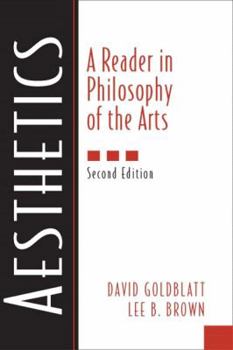Aesthetics: A Reader in Philosophy of the Arts
Select Format
Select Condition 
Book Overview
Aesthetics: A Reader in Philosophy of the Arts, fourth edition, contains a selection of ninety-six readings organized by individual art forms as well as a final section of readings in philosophical... This description may be from another edition of this product.
Format:Paperback
Language:English
ISBN:0131121448
ISBN13:9780131121447
Release Date:July 2004
Publisher:Routledge
Length:541 Pages
Weight:1.56 lbs.
Dimensions:1.0" x 6.0" x 9.0"
Customer Reviews
2 ratings
Need it
Published by Thriftbooks.com User , 14 years ago
This book is an excellent compilation of the most influential and meaningful essays on aesthetics. A must have for philosophers, artists, and art historians. Even if you are just somewhat interested in this book having just now stumbled upon it by some random freakish mistake, buy it, and you will find something in here that will give you some new perspective.
Understand the philosophy of art
Published by Thriftbooks.com User , 15 years ago
I read this book for a graduate seminar on the philosophy of art. This book is an excellent way to get a general idea of the vast field of philosophy of art. Aesthetics = philosophy of Art, thinking about art. Using writings from over fifty philosophers on art form Plato to Hans-Georg Gadamer gives the reader a great grounding in all of the philosophical theories of "what is art." The reader will find that how we engage art today is different then how the ancient Greeks did, art was embedded in a cultural context for them. Art was not in museums or in dance halls. Art is in a special zone of experience today in museums, etc. Tragedy for Greeks was part of their politics and religion, sculpture and painting the same way. Music until recently, (after the enlightenment) was for religion or some kind of official function. Philosophy tries to come up with theories about art; it may be a fool's errand. A set of principles that define and illuminates or explains the full measure of art is probably not attainable. However, just because a theory is wrong doesn't mean it has no value, we can draw import from all of them. By using excerpts from different philosophers the reader gets a good understanding of the major art movements, which I identify below. The "Imitation theory" of art- means it copies something in the natural world. Art refers to some objective reality outside the mind and artwork. (Plato, Aristotle). . Sometimes the imitation theory is also known as the "representational art theory" because the artwork represented something in the world but is not a simplistic idea of copying. The art forms that are most representational are representational sculpture, painting, and drama. The background and implications of the imitation theory first originated in ancient Greece. The imitation theory is the traditional theory that held sway with artists and philosophers up into the eighteenth century Romantic period in Europe. In order for one to fully grasp the meaning of the imitation theory, it is necessary to understand the nuanced meaning of the Greek word for imitation. The Greek word for imitation is mimçsis; thus, art is the imitation of nature for the Greeks. However, mimçsis is a very complex word with many nuanced meanings. It can also mean a representational copy. Plato uses it in speaking of painting. For example, if a Greek painter painted a bird that looked bird like, that would be a sense of mimçsis. Aristotle says art is an imitation of nature, but not just "copying" it. Aristotle does not mean that when art does what it does it reproduces a natural thing. Rather, what Aristotle means is that art impersonates the power of nature to produce something. Human art does something along the lines of what nature does which is very different. Nature produces a tree from out of its power of generation without any intervention from nature, a builder produces a house out of materials which requires the intervention of an agent; however, Aristotle s




